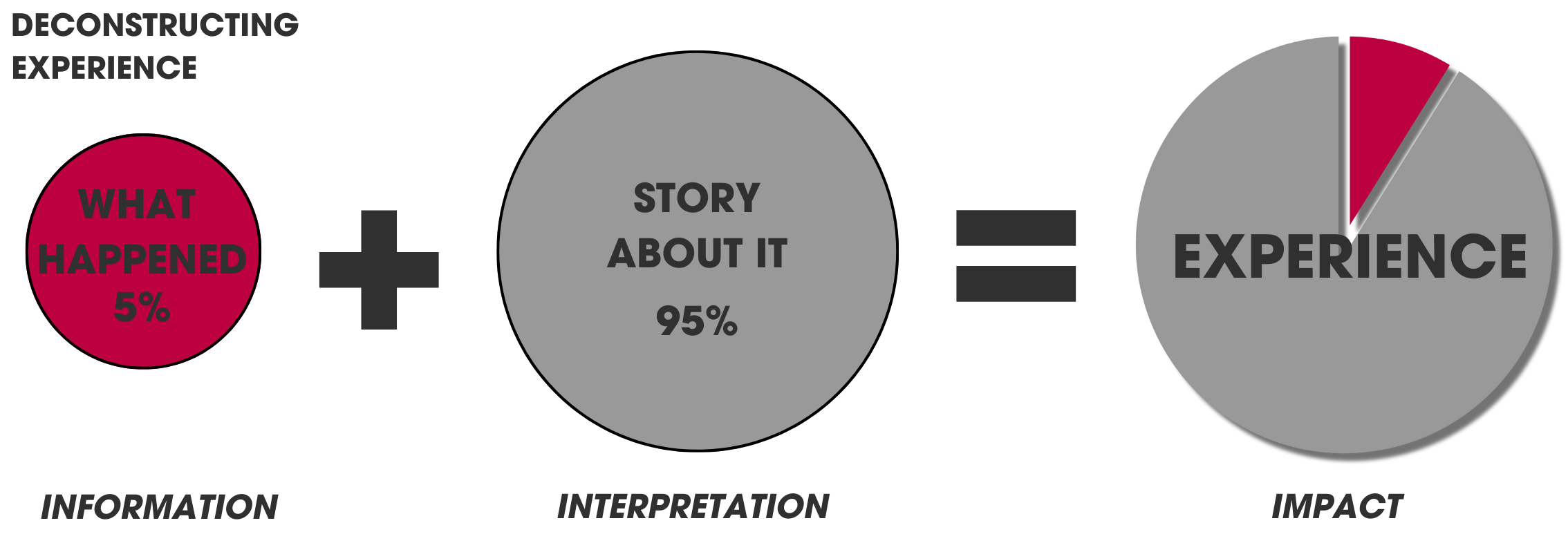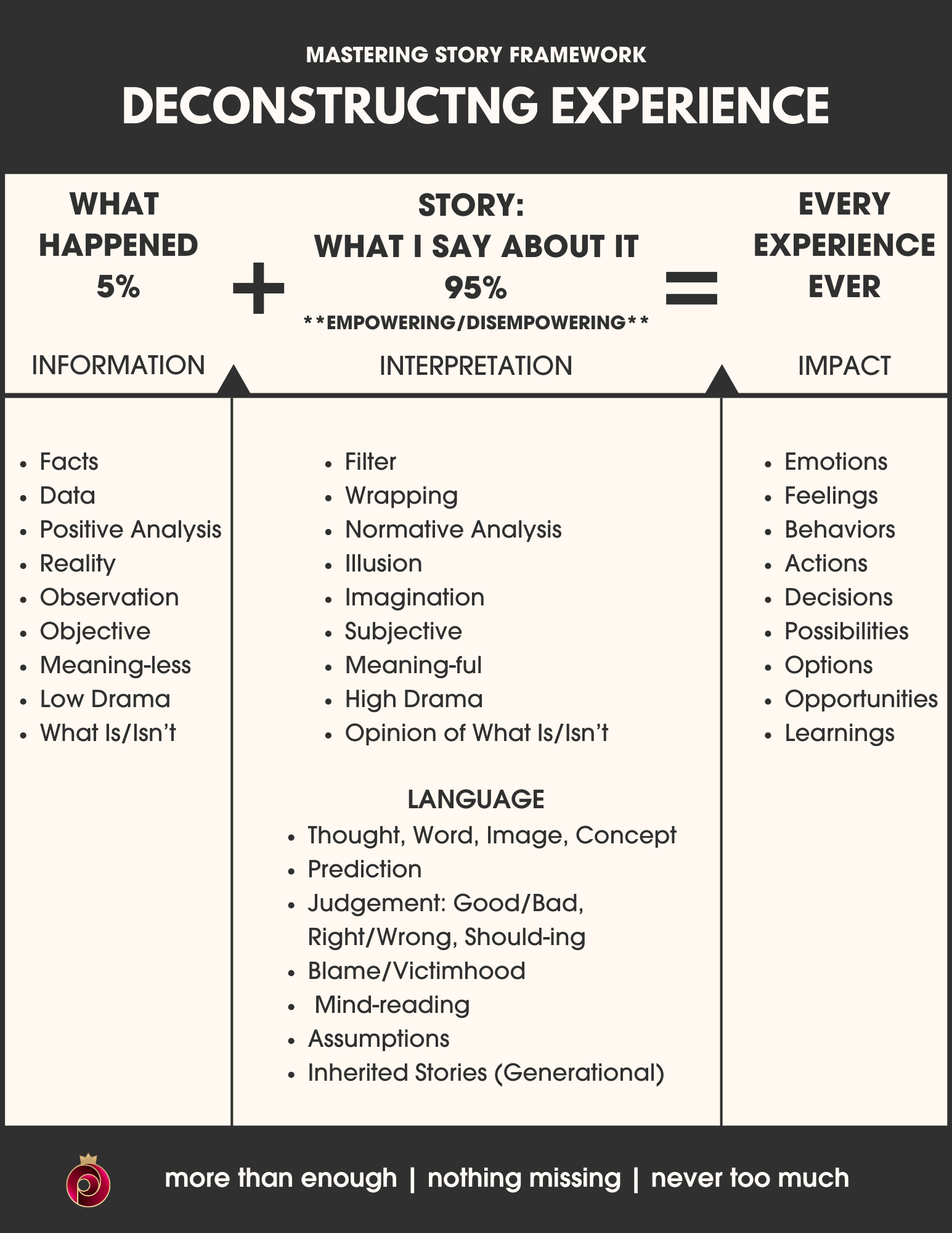BLINDED BY STORY:
Deconstructing Experience To Uncover Truth
3-Minute Read
I was strolling through lively downtown Austin on my way to meet my fiancé for lunch. I stepped off the crosswalk and onto the sidewalk when—bam—everything went black. I couldn’t see a thing. Someone was attacking me in broad daylight, their grip so tight it completely blinded me.
Adrenaline surged. My survival brain roared to life. I was ready to punch, kick, and scream my way to freedom—until I caught a whiff of cologne. His cologne.
I wasn’t being attacked. I was being hugged by the man I loved, who thought I’d spotted him as he waved at me across the street a moment before.
The second my vision went dark, my brain didn’t wait. It handed me one story: You’re in danger. It was instant, automatic, and utterly wrong—but I almost turned into the Tasmanian Devil because of it.
My experience in that moment is a picture of the challenge we all face in getting a handle on our default stories. Default stories are automatic and in turn, drive behavior. You always behave in a manner consistent with the story you’re telling. And the trickiest part is default stories are almost impossible to identify, unless you know where to look.
Today we’re showing you how to deconstruct an experience to effectively identify the default stories impacting your life. This is part one of a two-part framework for liberating yourself from the disempowered stories you tell. Next week we’ll give you the rest of the of the framework and show you how to use it to master your stories.
Let’s dive in!
deconstructing experience
An experience is derived from the combination of two things taking place simultaneously: What Happened and Your Story About It. It creates the illusion that your story IS what happened, but the truth is What Happened and Your Story About It are two separate matters.
As we said last week, you’re not having a direct experience with life. You’re having a distorted experience filtered through your story about life. Essentially, your experience is comprised of 5% What Happened and 95% Story. Story is the biggest driver of experience.
WHAT HAPPENED 5% + STORY 95% = EXPERIENCE
Let’s break down each part of this equation so you can see exactly how they work together.
WHAT HAPPENED 5%:
What Happened is INFORMATION (data)—objective, observable, and verifiable by others. It is reality, unfiltered and neutral. This belongs to Positive Analysis because it describes the facts—and only the facts—without interpretation. It is low drama and void of intrinsic meaning. In the words of Werner Erhard: “It is what it is and ain’t what it ain’t.”
STORY 95%:
Story is what you say about what happened, your INTERPRETATION—the lens through which you view events. It assigns subjective meaning, often influenced by values, bias, and past experiences. This belongs to Normative Analysis because it adds judgments to the facts, coloring and distorting how you experience reality. It is high drama and filled with the significance you give it. It’s your opinion of what is and isn’t.
The primary vehicle for your story is LANGUAGE. You’ll find your story in the following:
Thought, Word, Image, Concept
Predictions
Judgements: Good/Bad, Right/Wrong, Should-ing
Blame/Victimhood
Mind-reading
Assumptions
Inherited Stories (Generational)
Your story can be empowering or disempowering. You can create heroes just as easily as monsters, palaces as easily as prisons. Your story can be created intentionally or happen by default.
EXPERIENCE:
Experience is the IMPACT on your quality of life. It’s made up of your emotions, feelings, behaviors, actions, decisions and responses. It also includes the possibilities, options, and opportunities you see. It leaves you with lessons and learnings that further inform your filter of perception.
Not yet part of The Plenteous Life community? Subscribe to The Grip! Every week you’ll receive additional video, audio, and pdf tools directly in your email inbox to help you transform at both work and home.
identifying your default story
Every experience you’ve ever had can be summed up by the Deconstructing Experience equation. That said, identifying your own particular story in that equation can be incredibly difficult initially. We’ve got two ways to help you get started:
COMMON DEFAULT STORIES
The following is a list of default stores we often see in our clients. These are common to being human and particularly prevalent in innovators and leaders. You likely can relate to one or more below:
I’m not enough/I don’t measure up.
Something is wrong here or wrong with me/them.
I’m in trouble.
I can’t trust people.
Life is hard.
There’s never enough _____ (time, money, etc.).
Nothing works out for me.
People suck.
I can’t get ahead.
This shouldn’t be happening.
I’d rather be alone.
Being alone is terrifying.
I had no choice.
SPECIFIC DEFAULT STORIES
To dig further, you can audit the following areas of your life to uncover specific default stories unique to you.
Remember from last week, the framework for your stories gets established at a young age and reinforced the rest of your life. Your default stories are often the behavior of your subconscious brain just running the instructions it learned a long time ago.
These stories will often sound absurd to your conscious, adult mind. So, for the practice of identifying your default stories, audit these areas through the lens of 7-year-old you (or any other previous age when significant life-shaping events occurred). These old programs are the default stories currently running amuck in your life.
What meaning does each of the following hold for you?
Automatic Reactions: At what do you get angry, frustrated, hopeless or anxious?
Automatic or Repetitive Self-talk. This is often negative and critical.
Messages growing up about what is and isn’t possible for you: capability, money, relationships, health, career, etc.
Messages from home, school, community, and culture regarding what’s good/bad, right/wrong, should/shouldn’t.
Any conscious desire that continues to be unattainable after years of effort.
Painful experiences: trauma, loss, heartache, failure, or injustice.
Repeated patterns of life turning out in undesirable ways.
“We always behave in a manner consistent with the story we’re telling.”
Use this week to identify your stories. Write them down. Next week we’ll show you how to process your stories through the full Mastering Story Framework to create new experiences and set yourself free.
Use this week to identify your stories. Write them down. Next week you’ll use those stories in step two of the process to create new experiences and set yourself free.
Keep creating.
May you prosper in every way!
Becky & TPL Team




